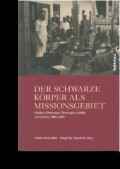If one could recommend one book to explain why the study of Christian communication networks in the era of colonisation is pertinent to our understanding of racialized bodies in our present-day globalised media, this one might be it. This book, having identified as topic for investigation the black body as missionising site in colonial Africa, goes in search of a variety of contexts in which black bodies in contact with white missionaries can be studied from the archival remnants at our disposal today: mostly textual and visual representations in the form of photographs, essays, reports, and, importantly, illustrated publications – popular as well as scholarly.
The book begins with a poignant essay by – and in a sense now, in light of his unexpected passing away in the same year that this book was published, in honour of – the late Patrick Harries, South African missionary historian from the University of Basel. Harries illuminates the coming of age of missionary history over the past few decades by relating it to his personal experiences of the making of the field. He explains the centrality of the body in this project as follows: “The Church […] disciplined converts’ bodies through baptism, marriage and funerals, decorative rites of passage seized from heathen peoples. It remembered the body after death through the erection of gravestones and memorials. The Church carried the African body back home to Europe in a series of publications, aimed at an extraordinarily wide range of readers, and museums and public exhibitions that drew large numbers of spectators.” (pp. 9–10)
In the second chapter, co-authors Ratschiller and Weichlein point out that it was at the hand of missionary knowledge that the people of Europe had developed the first detailed representations of Africa in world history. This chapter offers the prospective researcher interested in exploring missionary media for an understanding of the making of the African body with a backpack stuffed with nutritious theory, and an excellent map for positioning oneself in the dense historiographical and methodological landscape. In order to view the history of the body not only as a regulatory process, but also as a history of knowledge documenting the exchange between black and white bodies, the authors argue that one must read missionary sources against the grain and realise that the history of exchange is just as much a history of secrets, loss, strategic silences and congested communication channels. The authors of the volume approach the challenge at three levels: firstly by investigating the actors, networks and institutions of mission; secondly by looking into discourses, practices and identities and thirdly by tracing the interplay between religion, science and mediality towards the making of a missionary knowledge of the body.
In the chapter ‘Kranke Körper’ (Diseased bodies), Linda Ratschiller investigates the photography of the Basel Mission along the Gold Coast between 1885 and 1914, and the different ways in which the circulation of images played along in the making of tropical medicine as a field of knowledge. And yet, she emphasises that it also affected local representation in the Gold Coast itself, resulting from exchange, reworking and resistance within an interactive field of knowledge that most certainly had not resulted in any singular comprehensive unit.
In Karolin Wetjen’s investigation into the archive of the Leipzig Mission in East Africa between 1890 and 1914, she moves away from the diseased body to the circumcised and/or the baptised body, and the debate between missionaries, missionary societies and missionised congregations as to what constituted the Christian body. In her research, as in that of Ratschiller, the complexity and fluidity of exchanged views are emphasised.
Richard Hölzl writes about the Catholic mission in East Africa between 1911 and 1945, and the suffering body of the leper in missionary media and praxis. He illustrates how differently life in the leper settlement can be reconstructed from the colonial archive, compared to the project embarked upon in missionary publications, with its major aim to translate the bodies of patients into suffering vessels of souls in need of saving.
Katharina Störnig’s contribution focuses on the Vatican’s mission exhibition of 1925, asking whether it is possible to speak of globalised bodies when looking at the way the world and its population had been represented. She illustrates how the exhibition contributed to particular assumptions about the order of the world. Many of the groups and individuals who had been made to stand for something in the missionary media, had hardly any recourse to the technology and media employed to produce and distribute the knowledge about them.
Marcel Dreier continues the assessment of Catholic missionary media with a study of motherhood and modernity in Tanzania, 1930–1960. He emphasises that what may be perceived as the authoritative practices of Catholic sisters towards Tanzanian women, could have been appropriated by the latter as gateways enabling them to articulate themselves in new ways in their social context. He then concludes that unlike with Catholicism in Switzerland, where modern means were employed to reinforce conservative ideas, the gendered approaches to the welfare state in postcolonial Tanzania, inherited at least in part from missionary endeavours, affirm that the new ideas around motherhood were rather associated with development and progress.
The case study chapters each offer meticulously-executed research of a particular situation, pointing to recurrent themes but also emphasising the vast possibilities for innovative human responses and interaction. This must certainly encourage more researchers to investigate more of the wide range of possible contact sites and communication contexts to be excavated from the vast global missionary archive, considering that this volume mostly focuses on East-African encounters.
Anna-Katharina Höpflinger’s final chapter concludes that the contributions have all illustrated the ambivalence of religion: While it can serve to reinforce power processes and affirm boundaries, it also opens possibilities for subversion and the breaking down of hierarchies as well as racist and sexist conceptions associated with the body of either stranger or self.
